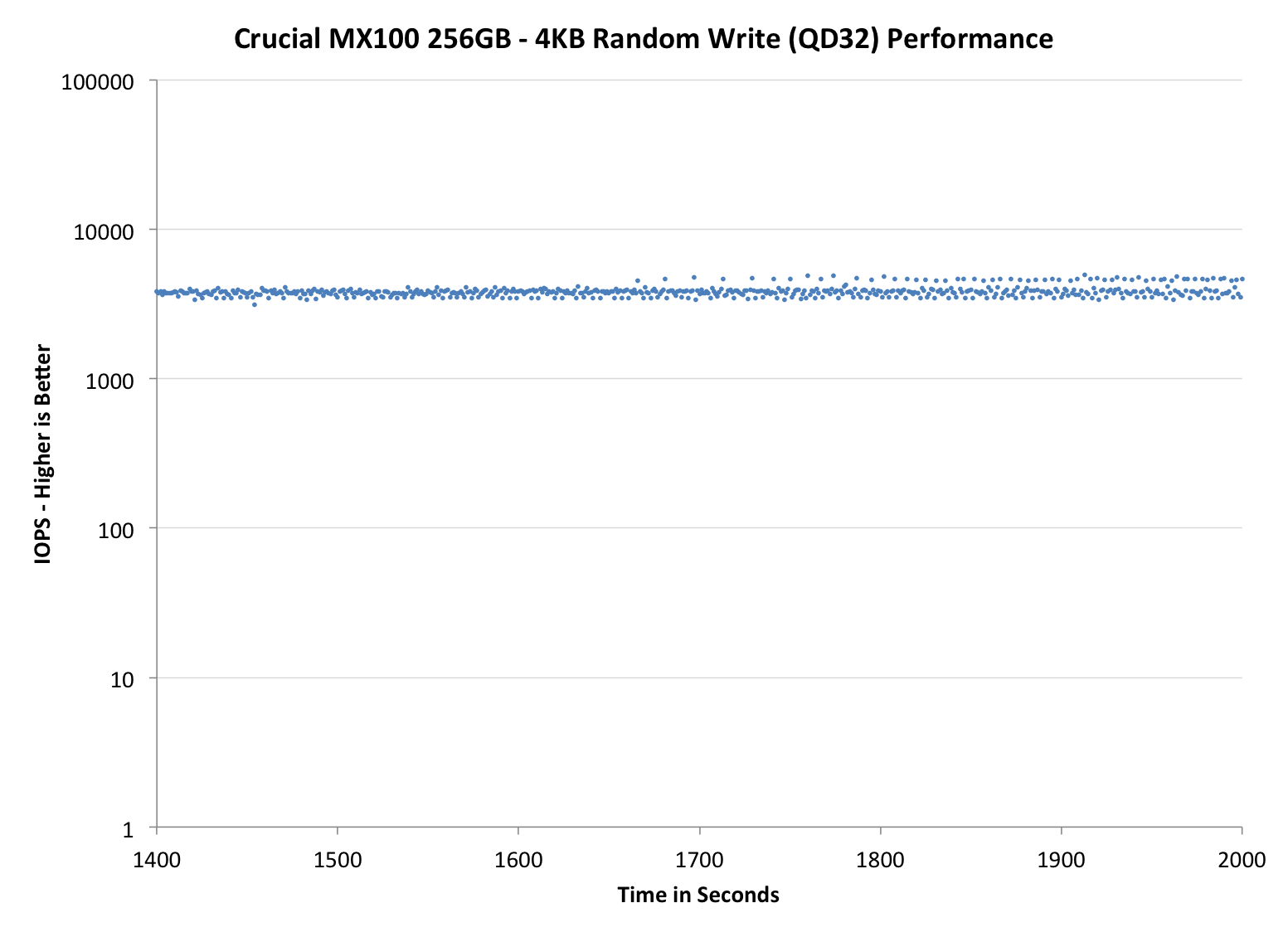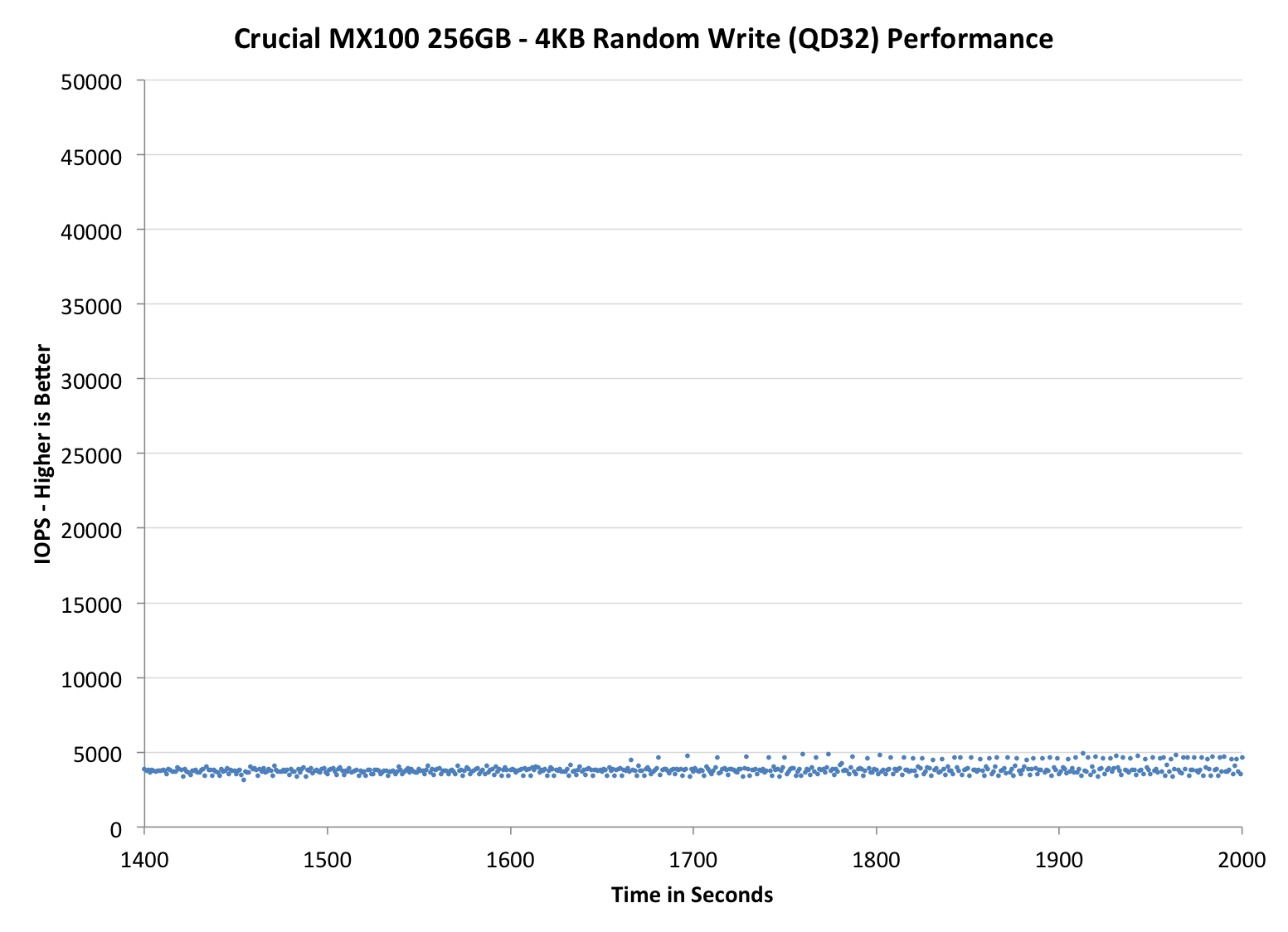Crucial MX100 (256GB & 512GB) Review
by Kristian Vättö on June 2, 2014 3:00 PM ESTPerformance Consistency
Performance consistency tells us a lot about the architecture of these SSDs and how they handle internal defragmentation. The reason we don’t have consistent IO latency with SSD is because inevitably all controllers have to do some amount of defragmentation or garbage collection in order to continue operating at high speeds. When and how an SSD decides to run its defrag or cleanup routines directly impacts the user experience as inconsistent performance results in application slowdowns.
To test IO consistency, we fill a secure erased SSD with sequential data to ensure that all user accessible LBAs have data associated with them. Next we kick off a 4KB random write workload across all LBAs at a queue depth of 32 using incompressible data. The test is run for just over half an hour and we record instantaneous IOPS every second.
We are also testing drives with added over-provisioning by limiting the LBA range. This gives us a look into the drive’s behavior with varying levels of empty space, which is frankly a more realistic approach for client workloads.
Each of the three graphs has its own purpose. The first one is of the whole duration of the test in log scale. The second and third one zoom into the beginning of steady-state operation (t=1400s) but on different scales: the second one uses log scale for easy comparison whereas the third one uses linear scale for better visualization of differences between drives. Click the buttons below each graph to switch the source data.
For more detailed description of the test and why performance consistency matters, read our original Intel SSD DC S3700 article.
 |
|||||||||
| Crucial MX100 | Crucial M550 | Crucial M500 | SanDisk Extreme II | Samsung SSD 840 EVO mSATA | |||||
| Default | |||||||||
| 25% Spare Area | |||||||||
The IO consistency is a match with the M550. There is effectively no change at all even though the 256GB M550 uses 64Gbit NAND and the MX100 uses 128Gbit NAND, which from a raw NAND performance standpoint should result in some difference due to reduced parallelism. I'm thinking this must be due to the firmware design because as we saw in the JMicron JMF667H review, the NAND can have a major impact on IO consistency because of program and erase time differences. On the other hand, it's great to see that Crucial is able to keep the performance the same despite the smaller (and probably slightly slower) NAND lithography.
With added over-provisioning there appears to be some change in consistency, though. While the 256GB M550 has odd up-and-down behavior, the MX100 has a thick line at 25K IOPS with drops ranging to as low as 5K IOPS. The 512GB MX100 exhibits behavior similar to the 256GB M550, so it looks like the garbage collection algorithms could be optimized individually for each capacity depending on the amount of die (the 256GB M550 and 512GB MX100 have the same number of die but each die in MX100 is twice the capacity).
 |
|||||||||
| Crucial MX100 | Crucial M550 | Crucial M500 | SanDisk Extreme II | Samsung SSD 840 EVO mSATA | |||||
| Default | |||||||||
| 25% Spare Area | |||||||||
 |
|||||||||
| Crucial MX100 | Crucial M550 | Crucial M500 | SanDisk Extreme II | Samsung SSD 840 EVO mSATA | |||||
| Default | |||||||||
| 25% Spare Area | |||||||||










50 Comments
View All Comments
juhatus - Wednesday, June 4, 2014 - link
Does the Samsung XP941 use Samsung's 3D NAND? Availability at least would fit as the first drive's where seen last Q3/13 on OEM machines..juhatus - Wednesday, June 4, 2014 - link
To answer for my own question: Yes and that also explains XP941's rarityhttp://english.etnews.com/device/2963105_1304.html
Kristian Vättö - Wednesday, June 4, 2014 - link
So far Samsung has only been sampling 3D NAND SSDs to enterprise OEMs, although they have just started providing some to the PC OEMs with the new 32-layer NAND. The XP941 is still regular MLC but Samsung it's only available for OEMs.Samus - Thursday, June 5, 2014 - link
I've installed over 100 M500's and have personally been using a C300 since 2010 in my daily driver laptop. Rock solid drives. Who cares if they're 10% "slower" than a Sandforce drive.Onyx2291 - Thursday, June 5, 2014 - link
Just ordered a 512GB for $199.99. Such good value.beatsbyden - Thursday, August 21, 2014 - link
Great bargain for the price. I heard the 256GB drive is in fact a 320 GB drive with 20% overprovisioning...that would even be more a bargain. Performance decrades less than with all other brands that only have 7%. I also like the protection and encryption on the mx 100. Still have to chose between the samsung 840 evo 250gb and the mx100. Would chose the mx100 if had better writing performance...but now i have doubts...Gonna use it for audioproduction...so lots of reads and writes that would make the samsung evo 840 a better choice right....i have a Samsung 830 128GB now and i'm satisfied with it, never failed me, but need a bigger one. Should i stick with Samsung or get the MX 100?SpartanTech - Wednesday, September 17, 2014 - link
Get the 512GB MX100, should satisfy your needs and provides even more storage....PS: Don't think you'll notice any difference tbh
Canadaram - Wednesday, October 22, 2014 - link
Because Crucial is a direct seller as well as a wholesaler, they can set the MSRP much closer to wholesale/street pricing levels, so don't expect as large of a discount from MSRP to street as you would on retail brands.akin1231 - Tuesday, December 2, 2014 - link
This drive is not a steal, it's a massive rip off because it doesn't work reliably. There's a massive issue with it falling off intermittently but frequently. There's no fix for it yet. Check the Crucial forum:http://forum.crucial.com/t5/Crucial-SSDs/MX100-wil...
I bought 3 of these... I'm a sucker
fossxplorer - Friday, April 10, 2015 - link
Good and very important info.